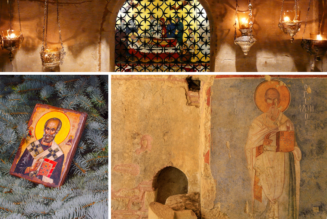Pillar subscribers can listen to this story here: The Pillar TL;DR – The Friday Pillar Post
Happy Friday friends,
And a happy feast of St. David to all of our friends and readers in the blessed principality of Wales. Or as it’s sometimes called by Americans, “Whales.”
For those who do not know, St. David’s Day is the patronal feast of Wales, not unlike that other Celtic national day later this month, but usually observed with rather more dignity and by people with an actual connection to the place.
By tradition, the people of St. David’s magical realm wear the national flower, daffodils, in honor of the occasion — from thence Welshmen get the common nickname “daffies.”
Well, from that, and from their tendency to get a bit incomprehensible and sing-songy when excited.
St. David was a sixth-century monk who created his own rule, based on the Eastern Fathers and with a strong penitential emphasis. His rule was not for sissies. Farming was required, but monks were expected to pull the plows themselves.
Absolutely no personal possessions were permitted, and strict vegetarianism was held. I actually think it would be considered closer to “veganism” these days, but I consider that more of an unnatural ideology than a diet, so let’s not call it that.
Anyway, it was the meat-shunning, plough-pulling, veg-munching lads of David’s crew, so myth and Shakespeare tell us, which gave Wales its national symbol: the leek.
The leek is more sustaining to eat than a daffodil, but looks a lot weirder worn on your lapel come March 1.

A serial attendee of local synods, St. David was such an eloquent and convincing refuter of pelagianism that he ended up being elected primate by his fellow religious and archbishop by popular acclaim.
These days, we can use all eloquent defenders of the faith in synods we can get, so St. David, pray for us.
Here’s the news.
The News
The Church’s roll of martyrs contains a lot of heroes, and a lot of examples to inspire us and help us make sense of the world we’re in today. And, according to San Francisco’s Archbishop Salvatore Cordileone, there’s one group in particular we should be paying more attention to.
He talked with The Pillar this week about why he thinks this is a category of heroic witness we need to be thinking about a lot more, what they have to teach us, and what the Church has to teach a world still very much enamored with Marxist totalitarianism in many places.
Read the whole interview here.
—
We continue to mark five years since Pope Francis’ global summit on the abuse crisis and the promulgation of Vos estis lux mundi.
As Luke scores it, 15 bishops have been subject to Vos estis investigations for negligence, which in a country of some 100 active bishops is a staggeringly high percentage.
The process there, as here, has faced a lot of criticisms, including a lack of transparency. But reading Luke’s work, my chief takeaway is that it would be hard to compile a similar list of U.S. cases with any real certainty.
Whatever the problems and faults with investigations in Poland, the bishops, including the nuncio, seem at least willing to publicly confirm when episcopal investigations have taken place, even if they aren’t terribly forthcoming about the result.
This is some serious reporting. Read the whole thing.
—
It’s not often that I read a proposal for reforming the canon law of future conclaves that makes me sit up and go “that’s so crazy it might just work.” But I read one this week.
Conclaves have been getting shorter and shorter in recent decades. Gone are the days when the cardinals would settle in for months, even years of deadlocked politicking. The 2005 and 2013 editions returned results in barely more than 24 hours.
The old adage that the man who goes into a conclave as a pope comes out a cardinal simply doesn’t hold true anymore — it’s become a game of front-runners.
First ballots are important shows of strength and, with the college increasingly drawn from all over the world and cardinals not tending to know each other terribly well, the way of things now is for momentum to gather fast and end things early.
But this in turn makes pre-conclave maneuvering much more important and (as Melloni points out) well-timed but ultimately ephemeral media mini-scandals right before the doors close can be enough to steer events. None of that is good.
Slowing down the process might be the best way to help the cardinals get to know each other, actually disconnect from the outside world, and start asking some real questions — of themselves, each other, and (dare we hope) the Holy Spirit — about who is best suited to stepping into Peter’s shoes.
Read the whole analysis here, because I’m sold on this one.
—
In a rare and wonderful win for the ecclesiastical little guy, a group of Canadian Catholics say the Vatican has overturned the suppression of their parish, and the closure of their little church, after they rallied to purchase the parish church in a 2022 auction.
Holy Rosary was one of 18 parish churches in the Archdiocese of St. John’s, Newfoundland, Canada, placed up for sale in 2022.
The sale was part of an effort to resolve an archdiocesan bankruptcy filing and a court order to compensate victims of sexual abuse at a closed Catholic orphanage in Newfoundland.
Some members of the parish wanted to keep the church open as a sacred space. But a group of business leaders in their small seaside community wanted to purchase and redevelop the property — including the church building — as a community space, with a focus on “heritage,” “arts and culture,” and “health, wellness, and mindfulness.”
In an effort to save their church, the parishioners negotiated the division of the lot and bid on the smaller portion, which included the church building and about an acre of surrounding land.
With that done, they were able to set up a GoFundMe campaign in an attempt to save the church building. The campaign attracted thousands of donations, some from as far away as California, and they managed to buy back their own church.
But when they went to the archdiocese with their church, they were told the parish was still being closed down, and so the locals had to appeal to the Vatican — and last week they got their result.
While they are obviously over the moon, the silence from the archdiocese is pretty deafening, and a little ominous. It’s not clear if the archbishop is planning further appeals in Rome, or if he aims to simply restart the parish closure process all over again with a different set of justifications.
—
The Archdiocese of New York this week announced the cancellation of a series of “kinky” sex workshops booked to be held in the Sheen Center, the archdiocese’s official center for arts and the evangelization.
After initial reporting from The Pillar on Wednesday, an archdiocesan spokesman said the center’s management had already moved to cancel the events, which had been privately booked and were not part of its official programming. Though tickets were still on sale several hours later, and the last time I checked.
The events, headlined “Improv for Kinky People,” are billed as a way to “generate wild, fun engaging characters who convincingly engage with your partner in the bedroom or a dungeon without it feeling stilted or awkward.”
This is more or less a family newsletter so I’m not going to go into all the details here, but suffice to say this is a series of self-described live instructional sex sessions for the kind of deviant shenanigans of which nightmares are made.
That one of the sessions was (still is?) booked to take place at the center alongside a screening of a documentary film on Fulton Sheen gives you some idea about just how insane the situation is.
You can read the whole story here.
Latin is not dead. And to learn it, you don’t have to treat it like a museum artifact. At the Ancient Language Institute, we read, listen to, and speak in the language we’re studying. Check out our online classes in Latin, Ancient Greek, Biblical Hebrew, and Old English.
Big city problems
Following on from the recent stories in the Archdiocese of New York, both the funeral of Cecilia Gentili and the furor over the Sheen Center booking a series of, ahem, sins of the flesh seminars, a lot of people are angry.
Reasonably so. It is a scandal, in the proper sense of the word, for such events to be scheduled in Catholic spaces dedicated to worship or to evangelization.
I’ve seen more than a few demanding that heads roll and for “root and branch reform” of the archdiocese’s booking and screening policies for every venue. Under the circumstances, neither is necessarily a terrible idea. Something does seem to be going terribly wrong in NYC.
The knee-jerk urge is to blame lax policies or indifferent staff for the recent messes. Absent information to the contrary, it seems hard to conceive how the Sheen Center, for example, gave willing assent to hosting an onanistic fetish jamboree to run alongside a screening of a film about the life of Fulton Sheen.
I would hope that anyone attempting to book such an event there couldn’t have seriously expected a favorable response to an honest enquiry — and maybe there was some outright deception on the events’ basic title and premise. Though if there was, I’d have imagined that fact would have made its way more centrally into the archdiocesan response, which it did not.
But administrative failures — of process or basic common sense or both — to one side, I suspect that this was (another?) bid to book an event with the express purpose of creating a scandal.
As the number of examples start to mount, I think it’s worth asking, at this point, if the archdiocese isn’t the target of a campaign, deliberate or organic, to embarrass it.
If I worked in the Manhattan chancery, I’d certainly be mulling an fairly urgent archdiocese-wide memo telling every parish, charity, school, and affiliated Church organization to start sifting their booking sheets for anything new or unknown, and to start asking the kind of screamingly obvious questions that it’s abundantly, absurdly, scandalously clear they should have been asking all along.
Trying my best to be sympathetic here, recent events to one side, I can see a case for asking who in their right minds would think to enquire “Will there be any drag queens snogging in the sanctuary?” when booking a funeral, or “Are you planning to feature any live acts of deviant sex?” when hiring out an event space.
Absent any other context, if you’d proposed doing so as a matter of policy, people might reasonably ask if it’s maybe you who had a problem.
But, at least in New York, it’s everyone’s problem now.
In the wake of Fiducia supplicans, there’s been a lot of renewed focus and pressure on the Church — much of it in NYC— on the limits of pastoral engagement in situations still known and taught to be objectively sinful and immoral.
Alongside that has come a real impetus to provoke, to outrage, and to embarrass the Church — both from those outside and from some Catholics. Such things are nothing new, and tend to wax and wane with wider cultural conversations.
The answer in New York is a new and necessary vigilance, it seems obvious. And whether it’s gross negligence or insufficient policy that got us here, simply wishing the problem away isn’t going to work.
For everyone else, it should maybe serve as a warning. What happens in New York could soon be coming to a diocese near you.
Media watch
Something that crossed my radar over the last week was a watch review from Hodinkee — a kind of glossy online bible for watch nerds, which I consume avidly. As a business, the mag has been on something of a rocket ship trajectory over the last few years.
After starting up as a one-man “blog” back in 2008, it quickly attracted readers like me, who have a pretty limitless appetite for high horology reviews and industry news, especially if it is well written, knowledgeable, and comes with high-definition pictures of the latest releases.
The site did well enough that it put itself out for a series of capital-raising calls and took in a fair bit of investment, including from some of its celebrity readers. In 2018, it started selling watches instead of just reviewing them, becoming an authorized dealer for a lot of name brands as well as a trusted middleman in the often shady but always lucrative secondhand market.
By 2019, it was winning awards for being such an innovative online company and attracting tens of millions of dollars in outside investment.
But as the business has grown, it’s lost a lot of the writers who made the magazine a pleasure to read — real watch obsessives with deep track knowledge of niche subjects in an already niche field. In their place have come a gaggle of Instagram kids and aspiring writers who are learning the beat as they go. There’s nothing wrong with that, per se, but it’s shown up in the quality of the coverage.
At the same time, the magazine has become, at least in my eyes, a lot tamer in its reviews, more deferential to big brands, outsourcing obvious criticisms to its own comment section in favor of mostly relentless positivity, often bordering on naked industry PR.
Case in point: its recent review of the Longines Master Seconds Small Hand.
This is, to my mind, a great-looking watch and the price point is, by industry standards, very reasonable.
But what stood out at me from the first picture was that it seems clearly influenced by the MR01 — a much cheaper offering from the French (not Swiss) start-up micro brand Baltic.
Baltic, despite being outside the magic circle of recognizable Swiss brands, is something of a darling among watch geeks for its design work.
Everyone loves them, and no one turns their nose up at your wrist if you sport a Baltic at a collectors’ meet, even though they retail at anywhere from a fifth to a tenth of most big brand offerings.
(Full disclosure, I don’t own an MR01 or a MSSH — I love them both but don’t have the cash for either.)
Micro brands as a business often trade on making cheaper versions of the big boys’ toys. They are called “homage” watches in the business, and they get a lot of flak for it. But to see the tail wagging the dog for a change, with a heritage house like Longines appearing to ape a cheap and cheerful young gun company, is — I would say — a fascinating industry news story in itself.
Yet Hodinkee’s review didn’t even mention it. Why?
It’s a common criticism of the watch industry press that reporters are too close to their subjects. That magazines, websites, and video reviewers rely on staying in the good graces of the big brands to keep access to the latest models. That closeness mutes criticism and even leads to occasional accusations of pushing PR releases as content.
The business model has become even more complicated for Hodinkee since it’s an authorized dealer for Longines, inter alia.
Now, I’m not accusing Hodinkee of knowingly looking away from the obvious story here, or doing so to curry favor or keep things sweet with a supplier. As I said, they’ve lost a lot of the experienced writers who would have spotted this as fast as I did.
I’m just saying it raises some obvious questions about the relationship between solid journalism to the subjects it covers.
For what it’s worth, the word around town is that Hondikee’s taken some financial hits in the last 18 months. Leaning heavily into investment and expansion into the retail end of things bit back hard when the COVID bubble in the secondary watch market started to deflate (yes, there absolutely was such a thing).
It seems to me like a cautionary tale about niche industry publications that start up online, garner a faithful readership through the hard work and savvy of their writers, and then start chasing the brass ring of big-time growth.
And I have, it should be obvious, something of a stake in that game.
When we started The Pillar three years ago, it was just JD and me. We didn’t really have a plan for how it would develop. We didn’t know if we’d be able to pay our bills, let alone one day hire other people.
And I’d have been incredulous if you’d told me by this point we’d have people of the quality of Michelle, Luke, Brendan, and Edgar either writing here full-time or contributing regularly. Or that we’d have not one podcast but a slew of them coming online, thanks to our incomparable producer Kate Olivera, and people like Dr. Scott Powell.
But here we are. And the two words that keep me up at night are “sustainability” and “growth”.
We run, as I hope everyone knows, on a simple paying-subscriber model. Sometimes we get sponsors for a few podcast episodes or the occasional newsletter, but our bottom line comes down to being a newsstand with an honesty box.
We trust that people who can afford to subscribe to read The Pillar will choose to do so. For their money, they get Luke’s daily Starting Seven news roundup (which is frankly worth the price on its own), podcast bonus episodes, and our new news-read-out-loud show The Pillar TL;DR, but we rely on those subscriptions to keep our news otherwise free to read for those who really cannot afford the $8.
Since we launched TL;DR this week, we’ve heard from, and happily handed out complimentary subscriptions to, more than a dozen priests, seminarians, religious, and to people like Catholic school teachers, too.
Those are the people we — you — are helping keep our work free to air for. I’m really proud of that.
It’s not a perfect model, to be sure. Our “churn rate” means that we lose about 15% of our subscribers every year, mostly due to payment details changing and renewals failing. It’s just part of the game. But it means if we aren’t constantly growing by about 15%, we’re going backward, and that’s when my insomnia kicks in.
At the same time, we want to do more than stand still. We want to hire more people, cover more news, better, and from other parts of the Church that aren’t getting the attention they deserve and need.
How we do all that is a constant conversation around here.
We have, thanks to you, the loyal readership and the website traffic, which — from what we can see — puts us far ahead of other English language Catholic news sites. We don’t choose to monetize that, though. Click-based ads lead, in our opinion, to click-bait reporting. And we never want that to be a temptation.
But it does make us an attractive prospect for all kinds of monetization and capitalization proposals. Something we’ve said a polite but firm “no, thanks” to, thus far.
Getting back to the Hodinkee analogy, I don’t think getting bigger faster (in dollars and manpower) necessarily means getting better. Mo’ money, mo’ problems, as Catholic rapper Christopher Wallace reminded us. We like things as simple as possible here.
JD and I take personal responsibility for every word we publish, and there is no one anyone can call to complain about us except us. We cover, within the finite hours we have in a week, the news we think needs covering and to which we think we have something truly original to add.
We don’t ask or owe anyone any favors. That means we can afford to be unpopular when we need to be. It also means cardinals and bishops sometimes tell us we’re too liberal, or “anti-Francis,” or just plain menaces. Sometimes we even get churchmen asking us not to write nice things about them, in case that gets them in trouble. It’s the game we’re in.
We, I, really want us to stay in that game, and to keep playing it on exactly the same terms as the day we started: free, fair, faithful, independent. That’s how we want The Pillar to be and to stay.
Maybe we would sleep better financially, or be more popular, doing this all another way, but I really hope we never have to try it or find out. For that, we rely on you.
So, please, if you read these newsletters and rely on the news we produce, help us keep doing this just the way we are. Because we ain’t no sell-outs.
Thanks, and see you next week,
Ed. Condon
Editor
The Pillar
Latin is not dead. And to learn it, you don’t have to treat it like a museum artifact. At the Ancient Language Institute, we read, listen to, and speak in the language we’re studying. Check out our online classes in Latin, Ancient Greek, Biblical Hebrew, and Old English.
Comments 19
Services Marketplace – Listings, Bookings & Reviews














